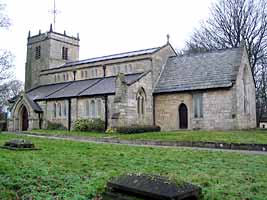For this church:    |
 SkegbySt AndrewNewark Archdeaconry Newstead Deanery IntroductionPrior to 1860 Skegby church was a chapel of ease of Mansfield St Peter. The stone building consists of a chancel, nave, north and south aisles, south porch and west tower with pinnacles and three bells dated 1684, 1737 (recast 1908) and 1830. The Norman chancel arch was destroyed during restoration by Stevens & Robinson of Derby in 1869-70, when the north aisle, clerestory, organ chamber, porch and vestry were added. The interior is plain with white walls. There is a medieval piscina in the south aisle and a stone pulpit. The altar and reredos date from 1947. Two ancient stone effigies, one of which is said to be a forester Edmund Spigurnell and his wife, although Pevsner doubts it. Also there is a kneeling figure of a priest against the south wall. The walls contain fragments of medieval cross slabs bearing emblems such as a chalice, sword and shears. There is a memorial tablet to John Lindley (d1797) by William Stretton of Nottingham. There are also others for Lydia Morley (d1768) and members of the Sheppard family. The manual pipe organ was added in 1873 and altered to electric in the mid-1940s. In 1980 it was replaced with a Norwich two manual electronic organ. The east window by C E Kempe was installed in 1893 in memory of the Rev Frederick Taverner, the first vicar when the parish was formed in 1860. The church was in a ruinous state in the late 19th century due to subsidence caused by coal mining. Girders were used to repair the tower, the chancel arch was supported by timber balks and an iron band put round one column. The floor was uneven with cracks in the walls. In 1984 the chancel was entirely demolished and rebuilt due to mining subsidence. Particular thanks to Amy Calladine, Michael Jones and Andy Nicholson for research on this entry |





